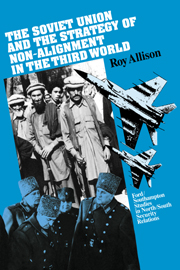Book contents
- Frontmatter
- Contents
- Acknowledgements
- Introduction
- 1 The Soviet view of non-alignment in the international order
- 2 The Soviet Union and the search for international security by the non-aligned states
- 3 Soviet policy and neutralisation in the Third World
- 4 Soviet policy and military alignment in the Third World
- Conclusion
- Notes
- Select bibliography
- Index
1 - The Soviet view of non-alignment in the international order
Published online by Cambridge University Press: 15 December 2009
- Frontmatter
- Contents
- Acknowledgements
- Introduction
- 1 The Soviet view of non-alignment in the international order
- 2 The Soviet Union and the search for international security by the non-aligned states
- 3 Soviet policy and neutralisation in the Third World
- 4 Soviet policy and military alignment in the Third World
- Conclusion
- Notes
- Select bibliography
- Index
Summary
THE CONCEPT OF THIRD WORLD NEUTRALISM
The key to the development of non-alignment is to be found in the course of Soviet relations with Yugoslavia in the 1940s and 1950s. Since Yugoslav non-alignment was formulated at the expense of the USSR it has been ignored or disparaged in Soviet accounts of the early years of non-alignment and the inaccuracies this introduces into Soviet writings and statements on non-alignment should be borne in mind (see Chapter 2). Instead Moscow developed a confused notion of Third World neutralism with a legal and prescriptive basis influenced by the conduct and character of the European neutral states.
The prominence the Soviet leadership gave to neutrality in its policies towards Western Europe from the mid 1950s was strong evidence of the revision underway in the orthodox Stalinist conception of international relations. Under Stalin Soviet spokesmen had drawn a close link between the ideological and military polarisation dividing East and West; this orthodoxy had precluded any real appreciation of a ‘third way’. Khrushchev, however, recognised the significance of the decision by a large number of states to reject military–political integration in Western-sponsored military alliances. Following the death of Stalin, Soviet statesmen were particularly impressed by the course pursued by India and Egypt. Initially, Soviet obervers regarded certain European neutrals and the Third World ‘extra-bloc’ countries as part of a single international phenomenon. Soviet officials believed that these states shared important common attributes and accepted similar restraints on their foreign policies.
- Type
- Chapter
- Information
- Publisher: Cambridge University PressPrint publication year: 1988



